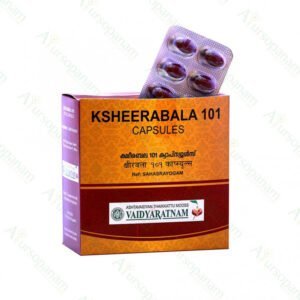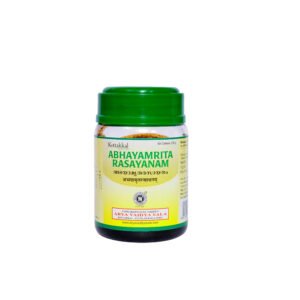Vata in its element is responsible for smooth locomotory function and nerve conduction. Rasnadi Kashayam is lauded for its therapeutic efficacy in ensuring sustained pain relief. Soola in Ayurveda denotes deep piercing pain in a given body part. Rasnadi Kashayam or Rasnairandadi Kashayam is capable of relieving such pain in the arms, thighs, hips, back, lower back and flanks.
Kashaya or herbal decoctions harness the healing properties of herbs and roots in a mild and easily absorbable water base.
Features & Benefits
- Rasnadi Kashayam is a simple combination that ensures easy and efficient joint care.
- The perfect balance of drugs which pacify deranged Vata-Pitta elements in the body.
- Rasnadi Kashayam strengthens alimentary canal and metabolic pathway, by restoring the efficacy of Vata.
- It clears up circulatory channels throughout the body, ensuring proper nourishment and healing.
- Rasnadi Kashayam draws out deep tissue edema. Breaks down Ama or disease-causing complexes in the body, that accumulate in the joints and deeper tissues.
- It modulates immune function. Rasnadi Kashayam also revives ojas and immunity.
Dosage and Instructions
Adult: 15-20 ml of Rasnadi Kashayam mixed with 45-60 ml of boiled and cooled water, twice daily on empty stomach.
Child: 10-15 ml of Rasnadi Kashayam mixed with 30-45 ml of boiled and cooled water, twice daily on empty stomach.
Key Ingredients
Rasna (Alpinia Galanga)
It is an Ayurvedic Medicinal which is a rhizome grown in most of Southeast Asia and is used in cooking and home made remedies. Rasnaplant is used in many Ayurvedic medicines in India, Tibet, Africa to help with inflammation, bronchitis, asthma, cough, indigestion, piles, joint pains, obesity, diabetes. The paste of the leaf is also applied externally to reduce swelling.
Eranda(Ricinus Communuis)
In the Ayurvedic medicine system, it is used in various preparations due to its medicinal properties. Ricinus is one of the strong laxatives. All parts of this plant are poisonous but seeds contain ricin which is a poisonous compound. It is the best remedy to cure tooth ailments and constipation.
Bala (Sida cordifolia)
The Ayurvedic system of medicine considers Balaor Sida cordifolia as a tonic, astringent, emollient, and aphrodisiac. The drug also forms a chief ingredient of several important formulations and preparations in Ayurveda. Internally, Balais believed to be a very effective nervine tonic and Rasayana for all kinds of Vata disorders.
Sahachara (Nilgirianthus ciliatus)
It is widely used in South India in various preparations and is considered as an important Vatahara drug. It is used in the treatment of Vata disorders, leprosy, to control blood sugar, urinal problems, jaundice, excess menses, etc.
Dushparsha (Tragia Involucrata )
T. involucrata leaf has been traditionally used to treat inflammation, wounds, eczema, scabies, and skin infections. It has also been found to be effective in treating pain and bronchitis. The Tragis Involucral root has been traditionally used for the treatment of high fever. It reduces the elevated body temperature to normal by its diaphoretic action.
Vasaka (Adathoda vasika)
Vasaka herb is used for treating cold, cough, chronic bronchitis, and asthma. in acute stages of bronchitis, vasaka gives unfailing relief, especially where the sputum is thick and sticky. It liquefies the sputum so that it is brought up more easily. For relief in asthma, the dried leaves should be smoked. The juice from its leaves should be given in doses of 2 to 4 grams in treating diarrhea and dysentery.
Devadaru (Cedrus deodara)
Himalayan cedar is very effective in neurological disorders, asthma, pruritus, infested wound. Devadaru is also effective in arthritis and headache.
Ativisha (Aconitum heterophyllum)
It is is effective in maintaining a healthy digestive system due to its carminative property. It is also helpful in diarrhea as it inhibits the growth of pathogenic microorganisms due to its antibacterial activity. Atis might also aid in weight loss as it lowers the levels of triglycerides and increases levels of HDL- cholesterol (“good cholesterol”). As per Ayurveda, it helps manage the symptoms of diabetes due to its Tikta (bitter) and Kapha balancing properties. Atis powder when consumed with honey helps to manage cough and cold due to its Ushna (hot) nature and removes the accumulated mucus.
Musta (Cyperus rotundus)
Musta is often used in Ayurveda to promote healthy menstruation. Great for reducing inflammation in the lower abdominal region, used in gastritis, fever, and associated burning sensations. Also helps in relieving mental stress and irritation leading up to menstruation. It is also used in the treatment of fever. Musta is also used in supporting the liver and digestive function.
Kokilaksham ( Hygrophila Auriculata)
Kokilaksha is considered as a Rasayana herb (rejuvenating agent). in Ayurveda, it is described as Ikshura, Ikshugandha, Culli, and Kokilasha, which means “having eyes like the Indian Cuckoo”. All parts of this plant are used (leaves, seeds, root) for medicinal purposes and have a slightly bitter taste. Kokilaksha is considered good for men and helps in managing erectile dysfunction by increasing testosterone levels. It also improves sexual stamina due to its aphrodisiac property. Kokilaksha also helps to manage blood sugar by preventing damage to insulin-producing cells due to its antioxidant property.
Shati (Hedychium Spicatum)
It is an Ayurvedic herb is known to treat digestive disorders, cardiac, debility, blood disorders, respiratory afflictions, and skin diseases. Shati, the medicinal plants are known for different names viz. Gandhamula, Sthulakanda, Gandha, Jatila, Dravida, Palashi, etc. The main important part of this plant, which is used for medicinal purposes, is rhizomes.
Guduchi (Tinospora cordifolia)
It is a well-recognized and widely distributed traditional plant that is used successfully in Indian Ayurveda medicine. Guduchi helps increase the effectiveness of protective white blood cells which fight infection. The herb also augments immune responses to infections by influencing various immune effector cells and ensures early recovery. Its effective in Infections in the respiratory system, skin, and soft tissues, Infected wounds, especially in diabetic conditions and immune-compromised conditions.
Shunti( Zingiber Officinalae)
The dry form of ginger is a common spice in the Indian kitchen. It bears an enormous number of pharmacological activities among those, Neuroprotective activity and activity against colon cancer have facilitated the extent of further research for finding out less toxic and more potent drugs for the better treatment of related diseases. Ginger is extensively used around the world in foods as a spice. Ginger has been used for cold-induced disease, nausea, asthma, cough, colic, heart palpitation, swellings dyspepsia, loss of appetite, dyspnoea, vomiting, gastritis, thirst, postpartum disorders, and rheumatism. It is a carminative antipyretic and is used to treat bronchitis, gastrointestinal disorders, and piles.
















































Ratings & Customer Reviews
Reviews
There are no reviews yet.